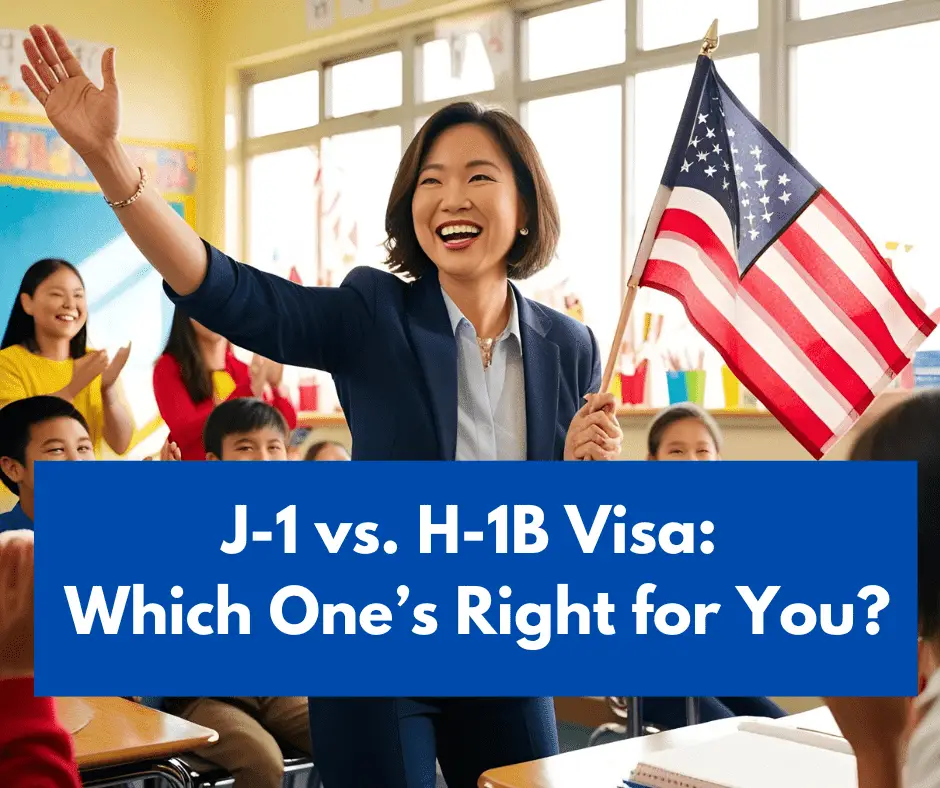If you’re dreaming of teaching or working in the U.S., you’ve probably come across two popular visa options: the J-1 and H-1B. But what exactly do they offer—and which one fits your goals better?
Let’s break them down in a simple, no-jargon way based on the latest updates from USCIS and the U.S. Department of State.
🧳 What is a J-1 Visa?
The J-1 visa is designed for cultural and educational exchange. It allows you to gain U.S. experience through programs for teachers, interns, researchers, and other professionals.
This visa is perfect if you want to grow professionally, explore another culture, and return home with new skills and stories.
✅ Best For:
-
International teachers and interns
-
Professionals looking for short-term U.S. experience
-
Exchange-based programs focused on cultural learning
👍 Pros:
-
Faster processing and easier access
-
Flexible options for 1–5 years depending on your program
-
Great for personal and professional growth
⚠️ Cons:
-
Some J-1 holders must return home for 2 years before applying for a green card or H-1B (unless you get a waiver)
-
You’re tied to your sponsor organization, not your school
-
Limited long-term immigration options without a change of status
🔗 Learn more: j1visa.state.gov
💼 What is an H-1B Visa?
The H-1B visa is for skilled professionals in specialized fields like education, IT, healthcare, and engineering. It requires a U.S. employer to sponsor you for a job that typically requires a bachelor’s degree.
If you’re thinking long-term—maybe even a green card someday—this might be your path.
✅ Best For:
-
Teachers with U.S. job offers
-
Professionals in specialized fields
-
Long-term work and immigration goals
👍 Pros:
-
Valid for 3 years, extendable to 6 years
-
Often leads to a green card (with employer sponsorship)
-
More flexibility—you can switch employers with a new petition
⚠️ Cons:
-
Lottery system applies (unless you’re cap-exempt—more on that below)
-
Requires more paperwork from employers
-
Competitive and limited spots if you’re applying under the regular cap
🔗 Learn more: uscis.gov
🏫 Special Note for Teachers: Cap-Exempt H-1B Employers
Here’s the part many international teachers don’t know:
If you’re applying to a U.S. public school district, charter school, or nonprofit educational organization, there’s a good chance they’re a cap-exempt employer.
🎉 What does that mean?
-
No H-1B lottery
-
No visa cap limits
-
You can apply anytime during the year
So even though the H-1B is known for being competitive, teachers working with cap-exempt schools have a much smoother path. That’s why many J-1 visa teachers eventually switch to H-1B through cap-exempt districts.
⚖️ J-1 vs. H-1B: A Quick Comparison
| Feature | J-1 Visa | H-1B Visa |
|---|---|---|
| Purpose | Cultural/educational exchange | Skilled work/employment |
| Sponsor | Program sponsor (not your employer) | U.S. employer |
| Duration | 1–5 years (varies by program) | 3 years, extendable to 6 |
| Cap Limit | No cap | Yes, unless cap-exempt |
| Green Card Path | Limited (waiver needed) | Yes, commonly used path |
| Job Flexibility | Limited (tied to sponsor) | Can transfer employers |
| 2-Year Rule | May apply after program ends | Not applicable |
| Filing Season | Year-round | Lottery season unless cap-exempt |
💡 So… Which One Should You Choose?
Let’s keep it real—it depends on your goals.
Choose J-1 if:
-
You want short-term experience and cultural immersion
-
You’re not yet sure about staying long-term
-
You want to start your U.S. journey quickly
Choose H-1B if:
-
You want job security and long-term work
-
You have a U.S. employer willing to sponsor you
-
You’re aiming for a green card or permanent stay
💡 And if you’re a teacher, don’t forget: cap-exempt H-1B sponsorship makes this path even more accessible than many realize!
✨ Final Thoughts
Both the J-1 and H-1B visas open doors—but to different types of experiences. Whether you’re starting your adventure or planting roots in the U.S., what matters most is aligning with a path that fits your vision, values, and future plans.
Do your homework. Know your options. And trust your journey. 🙌
Want to hear real teacher stories and tips on thriving in the U.S.? Explore more at Pinoy Teacher Stories.
If you want to teach in the US, please email your resume to apply@teach-usa.net.

